'Once glorious in its isolation'
The Horsfall Chapel
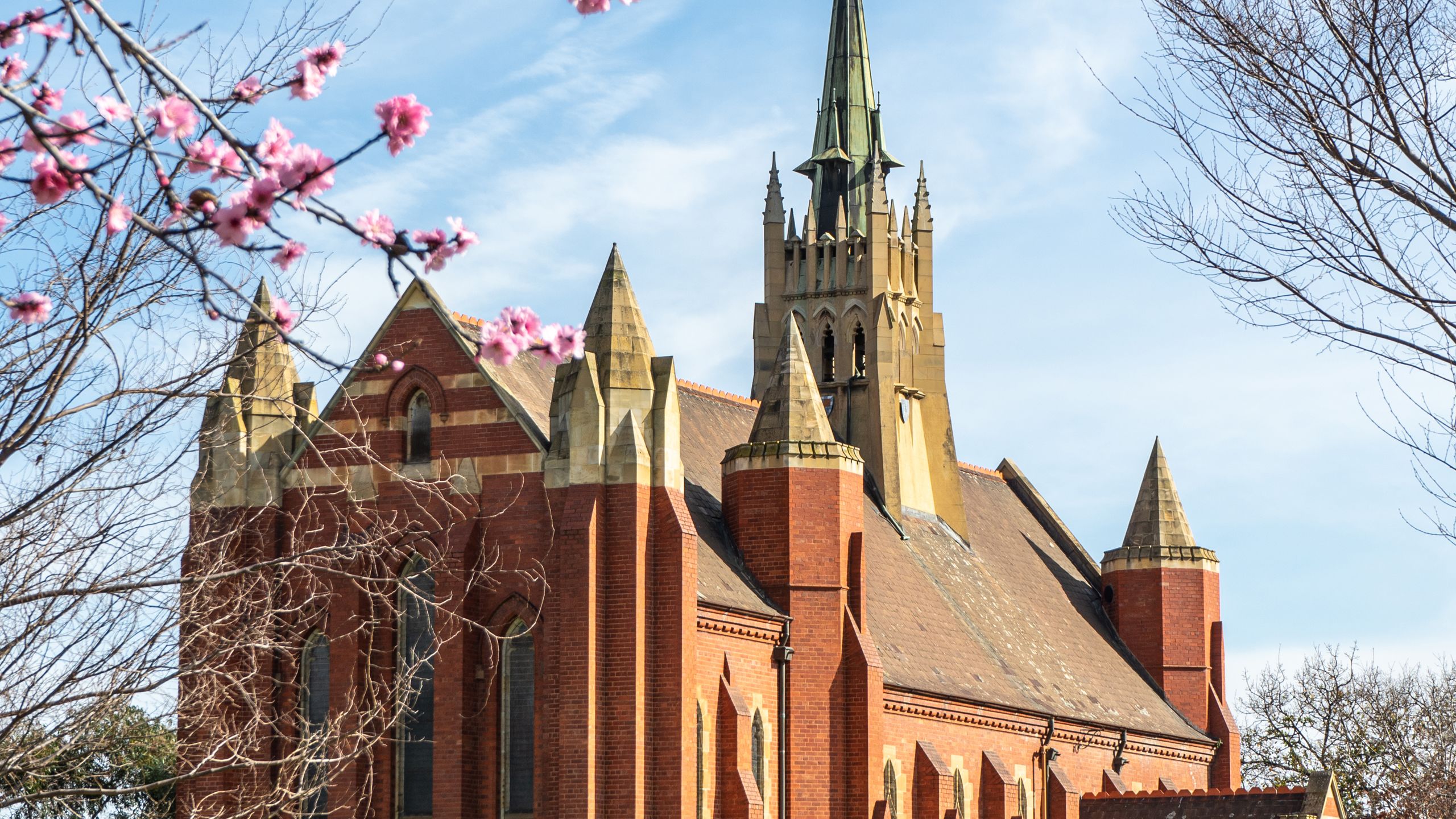
To some the centre of college life may be the common room, to others the sports field or the study fire, but surely in a College which exists for the Glory of the Eternal Trinity, the centre of its life should be the Chapel.
Like most good stories of Trinity, this one begins with a particularly festive college dinner. And a bottle of wine. Never forget the wine.
In July 1909, there was pressing need for the college to give serious consideration to a new chapel. A new chapel, for - since 1878 - the ground-floor common room in the Warden's Lodge (known today as Leeper) had been fitted up as a chapel, complete with ecclesiastically-themed stained glass in the room's eastern bay window.
The Latin phrase Sursum corda ('Lift up your hearts') was painted above the entrance doorway, and memorial plaques to those college alumni who had lost their lives while serving in the Boer War (1899-1902) a decade earlier now punctuated the walls.
With seating for approximately 50, here the college's earliest students would gather, including those students of Trinity undertaking theological training, which had commenced the same year.
In June, the Dean of Melbourne had moved a resolution, "That we pledge ourselves to cooperate heartily with the Bishop of Melbourne in carrying out the scheme for the training of theological students of the diocese at Trinity College."
Almost 30 years later in 1907, upon the death of Trinity's inaugural Principal, the Revd George Torrance (precursor to Leeper commencing as Warden, in 1876), a small throng of mourners crowded in to a memorial service held in the chapel - and made it abundantly clear that the room had more than outgrown its purpose.
As the Herald newspaper noted a few years later, 'This little chapel of Trinity College has been in existence for over 30 years.'
It bears the impress of reverential care, but it is totally inadequate for the requirements of the students. It seats but forty, while there are a hundred. This sounds strange, when it refers to the one Anglican college in Victoria. ... One wonders why more attention has not been paid to University churches. Officially there is no religious life at the University, though three colleges established by religious bodies exist.
The time may come, however, when the lofty spire will proclaim that this neglect, if neglect it be, is at an end.
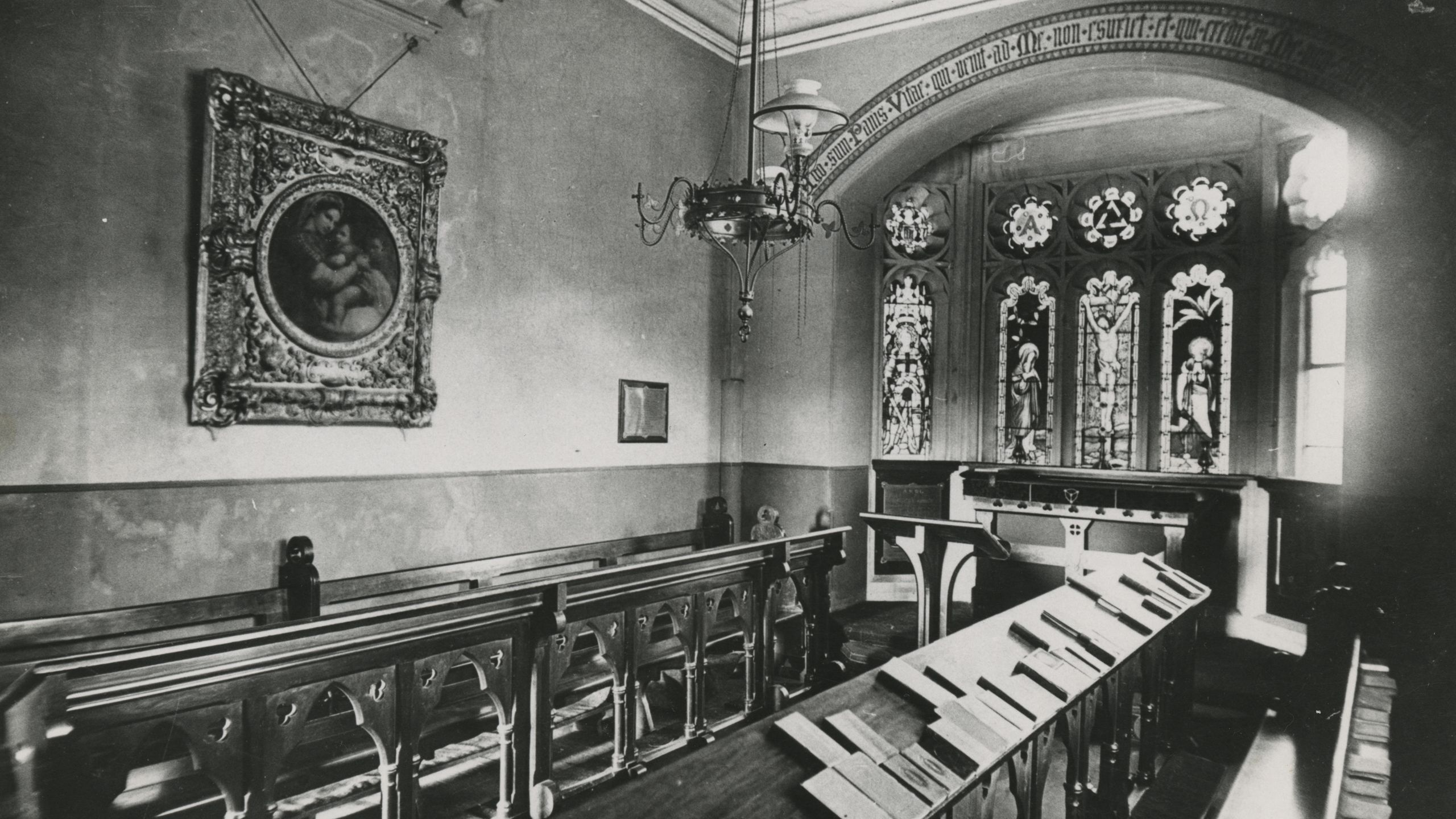
The original College chapel in what, for a brief period, had been the Common Room in the south-east room of the Warden's Lodge, c. 1910. Trinity College Archives, MM 000128
The original College chapel in what, for a brief period, had been the Common Room in the south-east room of the Warden's Lodge, c. 1910. Trinity College Archives, MM 000128
A new Chapel
By December 1909, the College Council was in the midst of reviewing 13 submissions received in response to an invited design competition, to produce a new college chapel at an estimated cost of £10,000. Half that sum would allow the first stage to be completed, it was believed.
Edmund T. Blacket's original 'master plan' for the college, prepared in 1881, had provisioned for a college chapel to one day front Royal Parade in the south-west corner of the campus.
Three decades later, this site still presented as the most suitable location, for what was hoped would be a realised master plan that would connect all the college buildings by cloisters; a concept which was held well in to the 1920s.
A chapel committee had been formed to review the design proposals, selecting design No.1 by the well-known Melbourne firm of Oakden and Ballantyne 'as first in order of merit'. But they held serious misgivings that the design submitted could be completed within budget and, if further advice proved those concerns well founded, they would assign first prize to design No.9, by Tasmanian-based architect Alexander North.
Yorkshire-born Alexander North was equally well established and arguably Australia's finest ecclesiastical architect of his day. Arriving in Australia in 1885, his early Tasmanian churches had embodied a simple French Gothic style, elements of which could still be discerned in his later architectural work.
Around 1900, he designed the new Holy Trinity and St John's Churches in Launceston, with a mixture of red brick and sandstone; design elements that would be highly familiar to those acquainted with Trinity's chapel.
As the chapel committee had anticipated, Oakden and Ballantyne's design - when independently 'priced up' - could not be constructed for the required sum.
North's design moved to first place for the College.
Lucien Dechaineux, a friend of North's and the principal of Hobart's Technical College, was engaged to produce some watercolours of the envisaged design, resulting in wonderful Arts & Craft-style sketches that - over a century later - remain in Trinity's archival collections.
But then things stalled.
Funds had not materialised through philanthropic support to the extent that had been hoped. The College had estimated £5000 being needed for the first stage; however, a rather paltry £300 had been raised to date. Of that, £100 had been given by the College Warden, Alexander Leeper himself. The situation looked grim.
And this is where the story of the lavish dinner emerges.
In the Argus newspaper at the beginning of March 1913, an article ran concerning 'A Noble Gift'.
'Mr J.S. Horsfall, of Orrong, Toorak, yesterday informed the warden of Trinity College (Dr Leeper) that he had decided to erect, at his own expense, a chapel for Trinity College, after the designs prepared by Mr A. North, of Launceston, who won the first prize awarded by the council of the college when competitive plans were called for some years ago.'
Almost 75 years later, the newspaper Church Scene recounts the tale's other variation:
'Legend tells that Mr Horsfall was inveigled into promising it at a particularly good dinner with the warden, Dr Alexander Leeper, and was dismayed to read, in a more sober frame of mind, in the Argus the following day that the gift had been offered and accepted.'
How much truth lies in the story remains unclear, but John Horsfall came good with his promised funding of the new chapel, a memorial to his late daughter Edith Carington, who had died in 1908.
The donation would, at the time, be one of the largest gifts made to the advancement of the Anglican Church of Victoria.
Not only had Horsfall pledged to fund the chapel's construction itself, but also 'all the necessary fittings, including the organ'.
'Old students of the college and churchmen generally will feel deep gratitude to Mr Horsfall for his munificent gift.'
With the funding secured, the foundation stone was laid in 1914 - months before the outbreak of war. Construction stalled, as both labour and building materials fell to short supply. Ballooning wartime inflation saw the college's builder go bankrupt and then in 1916 Horsfall died, depriving the chapel of its promised organ.
It would be a further three years before completion, and the Horsfall Chapel was finally consecrated in 1917, its distinctive Australiana-themed carved woodwork incomplete, no electric lighting and a vacancy on the bridge where the organ would finally be installed in 1923. It was also without a chaplain.
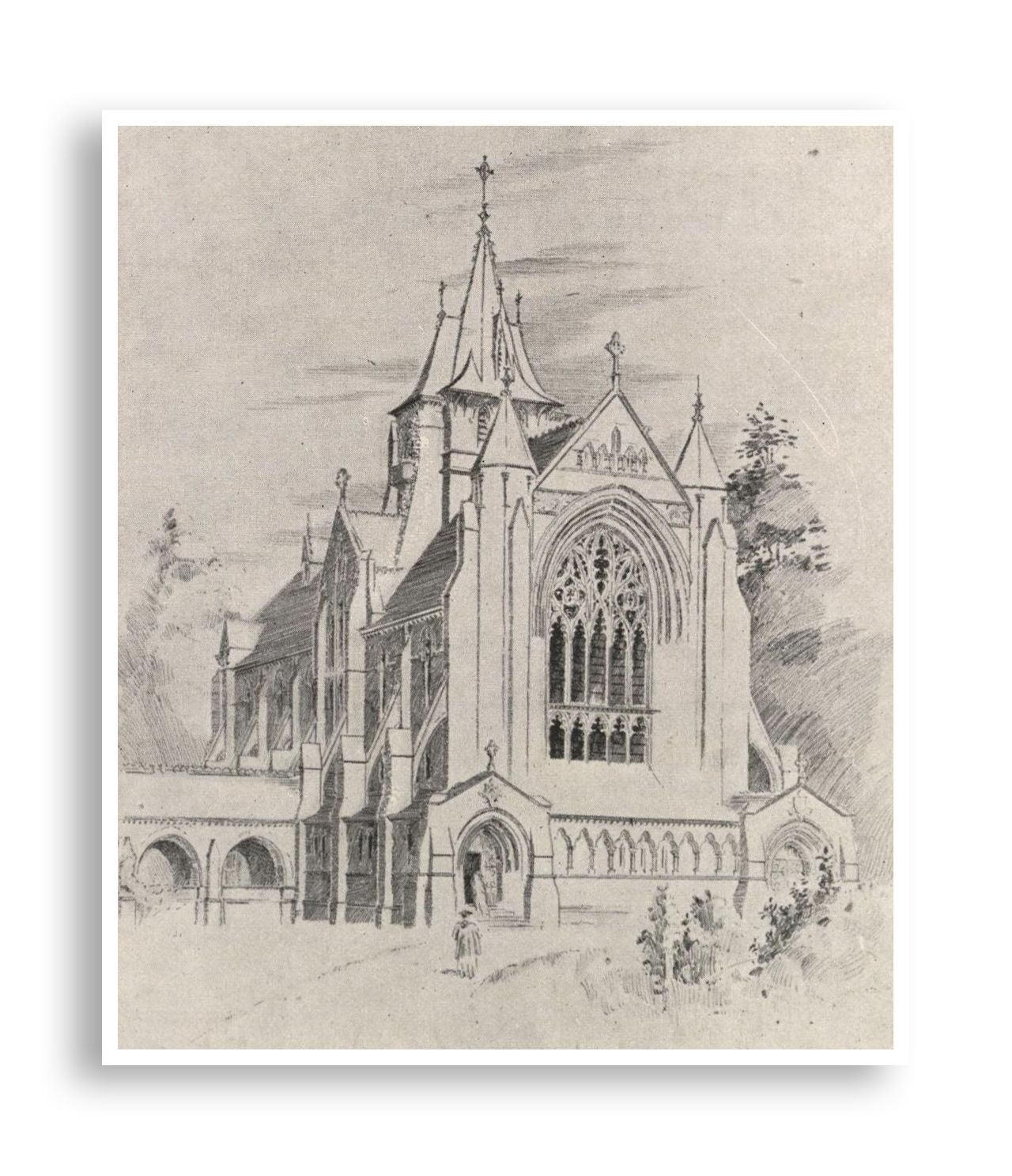
Sketch of North's successful competitive design for the Horsfall Chapel, Trinity College. Building, vol. 17 no.102, February 1916.
Sketch of North's successful competitive design for the Horsfall Chapel, Trinity College. Building, vol. 17 no.102, February 1916.
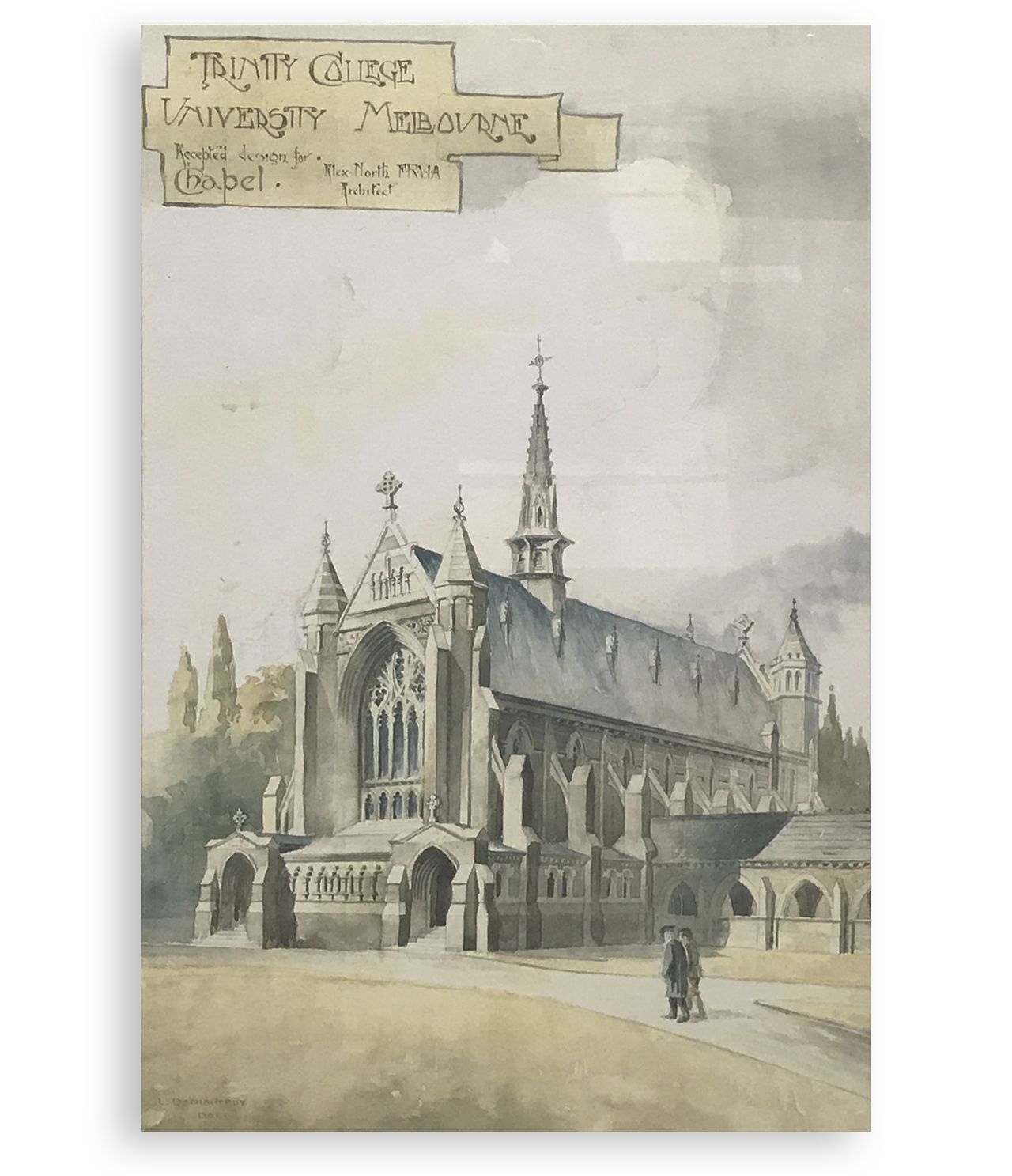
Lucien Dechaineux, 'Trinity College, University Melbourne, Chapel', c. 1911. Trinity College Archives, AC 000167.
Lucien Dechaineux, 'Trinity College, University Melbourne, Chapel', c. 1911. Trinity College Archives, AC 000167.
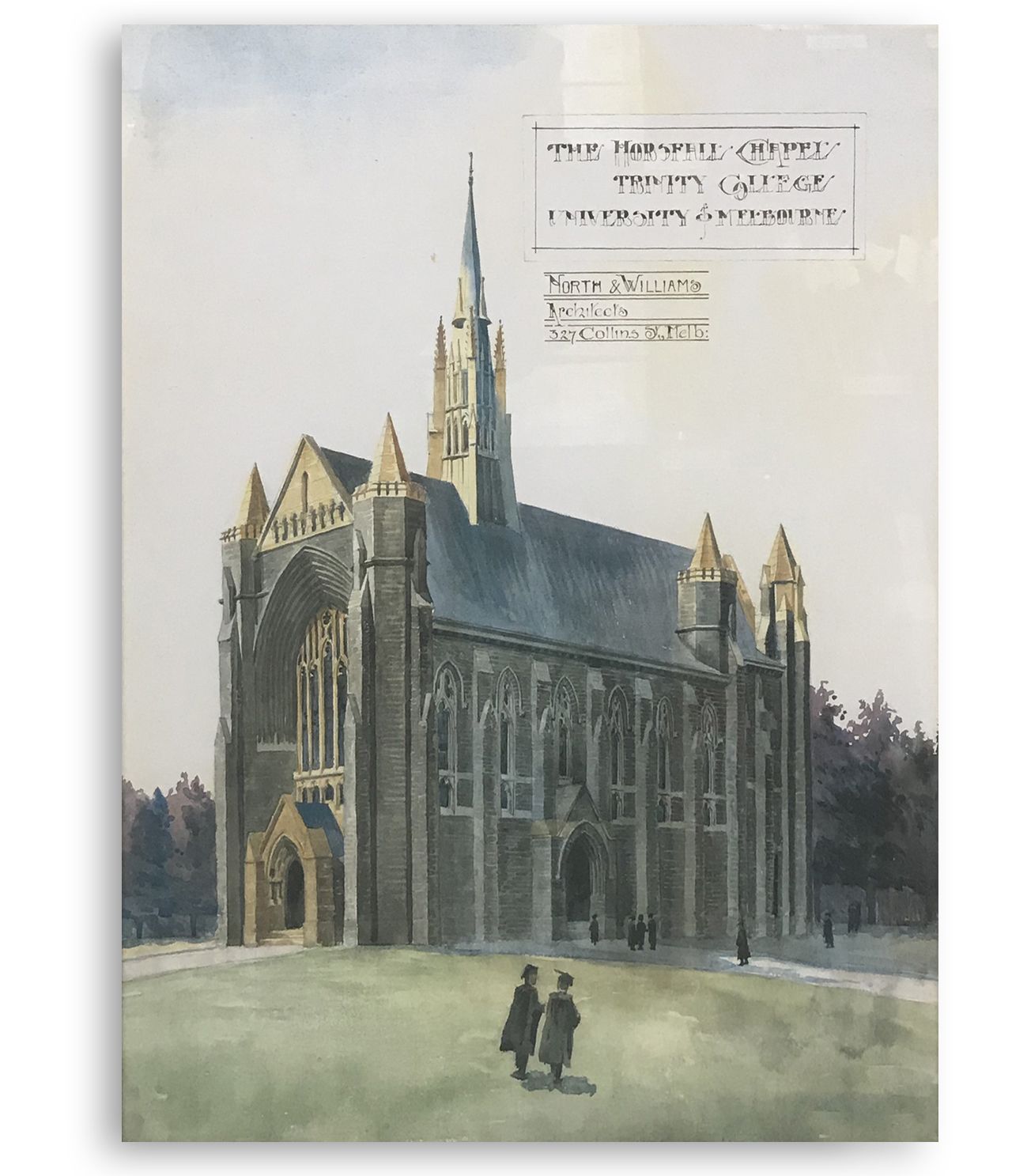
Lucien Dechaineux, 'The Horsfall Chapel, Trinity College, The University of Melbourne', c. 1911-13. Trinity College Archives, AC 000311.
Lucien Dechaineux, 'The Horsfall Chapel, Trinity College, The University of Melbourne', c. 1911-13. Trinity College Archives, AC 000311.
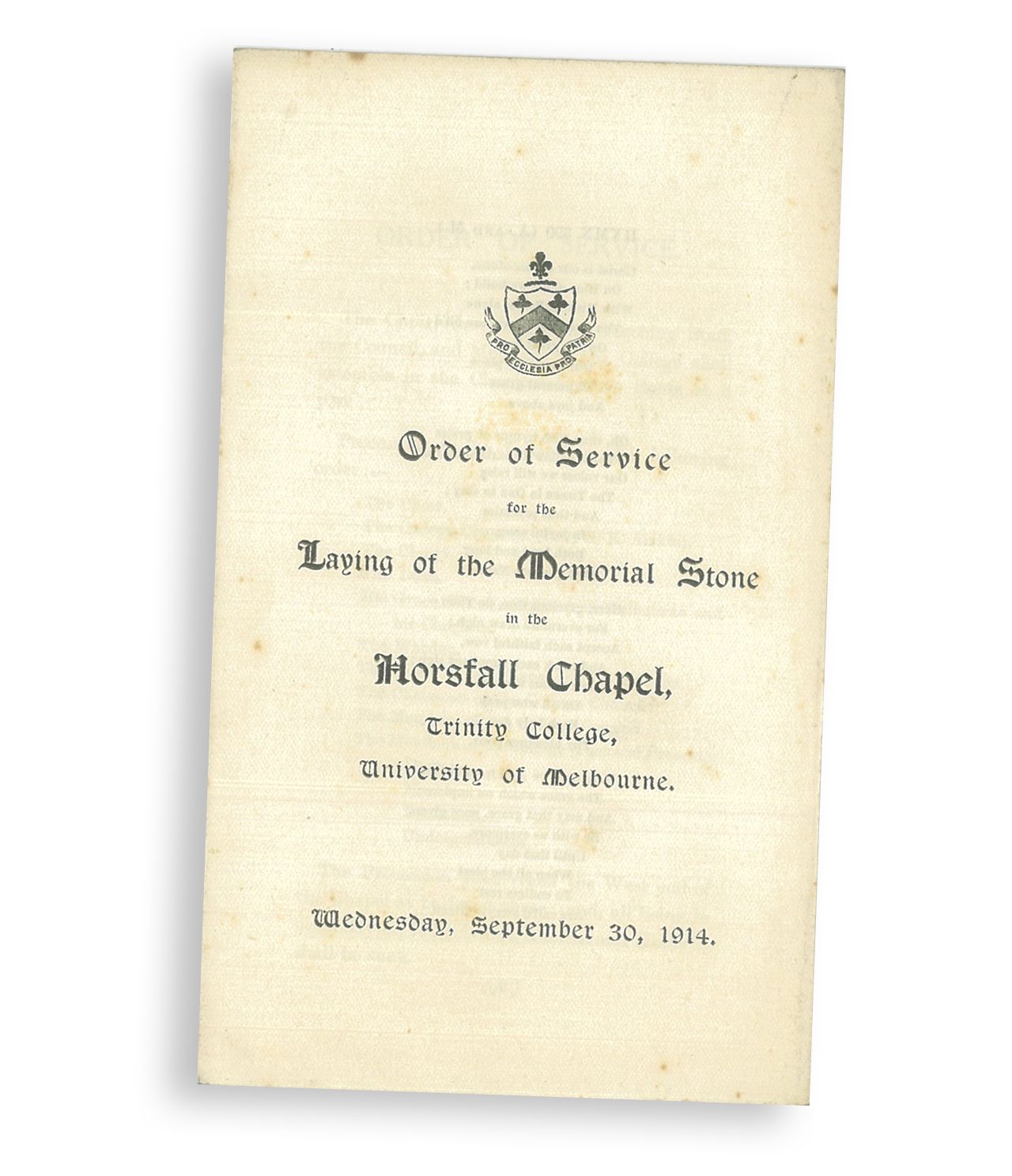
Order of Service, 'Laying of the Memorial Stone in the Horsfall Chapel, Trinity College', 1914. Trinity College Archives.
Order of Service, 'Laying of the Memorial Stone in the Horsfall Chapel, Trinity College', 1914. Trinity College Archives.
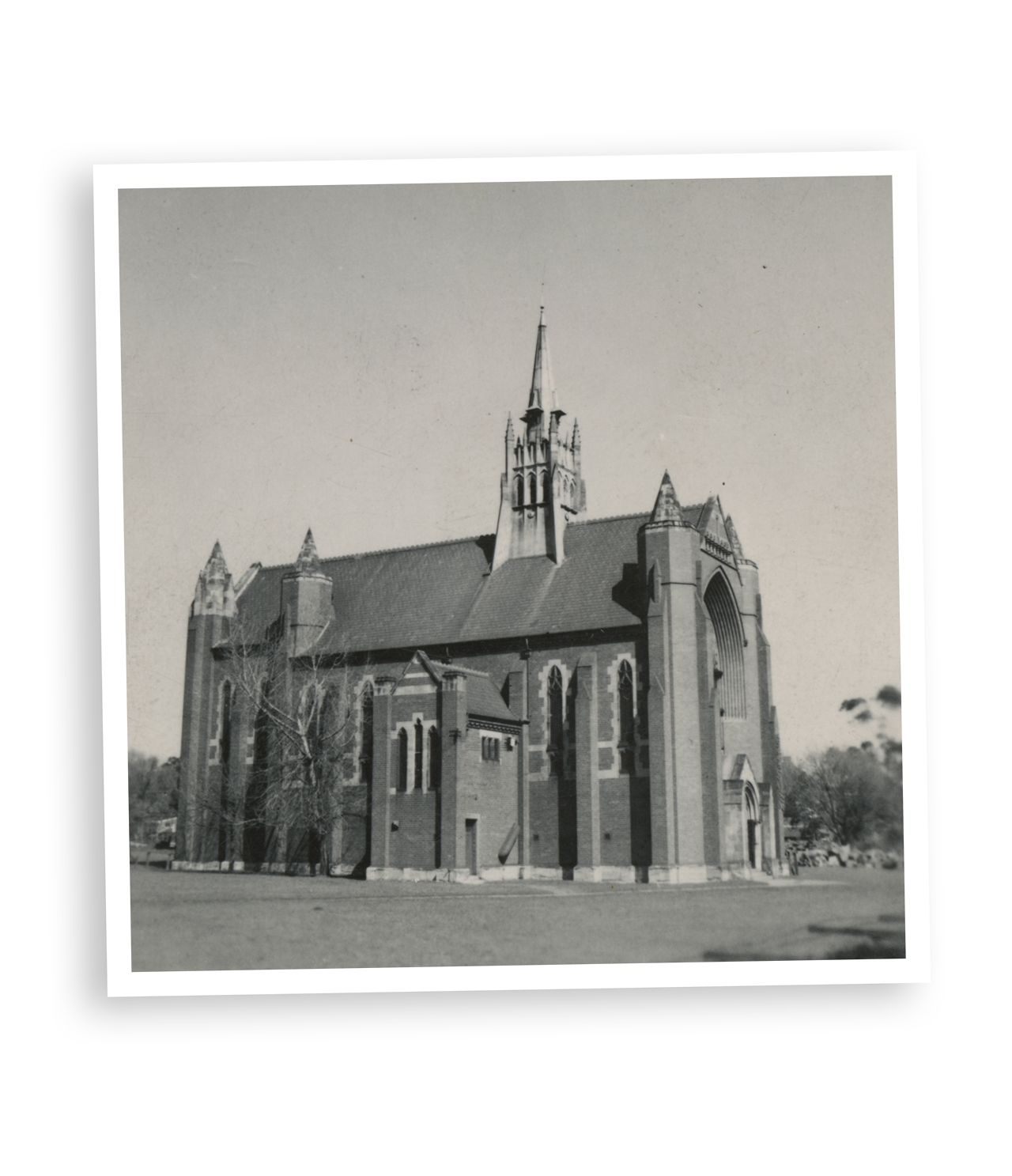
Trinity College Chapel, c. 1930s. Trinity College Archives, MM 000199
Trinity College Chapel, c. 1930s. Trinity College Archives, MM 000199
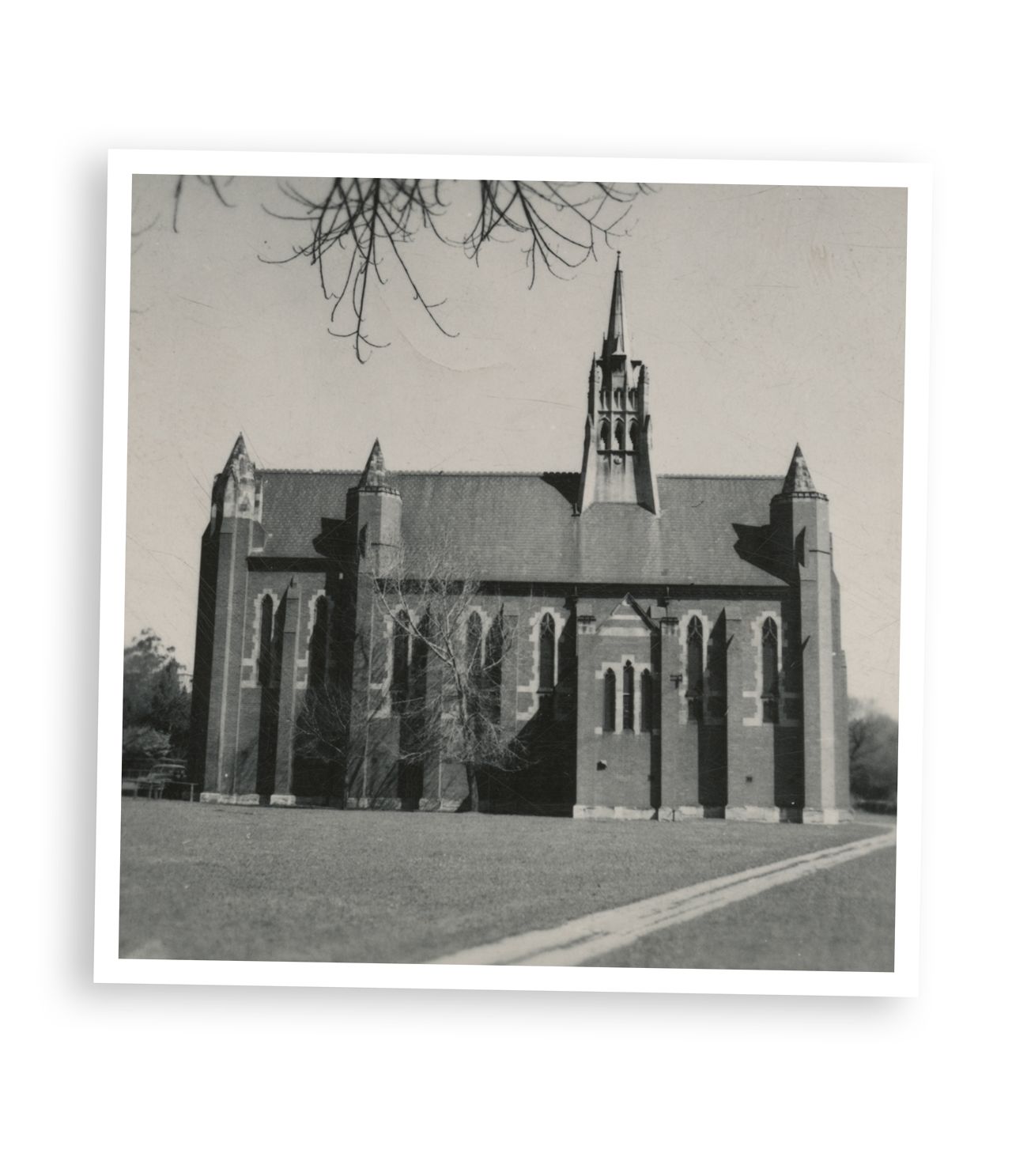
Trinity College Chapel, c. 1930s. Trinity College Archives, MM 000204
Trinity College Chapel, c. 1930s. Trinity College Archives, MM 000204
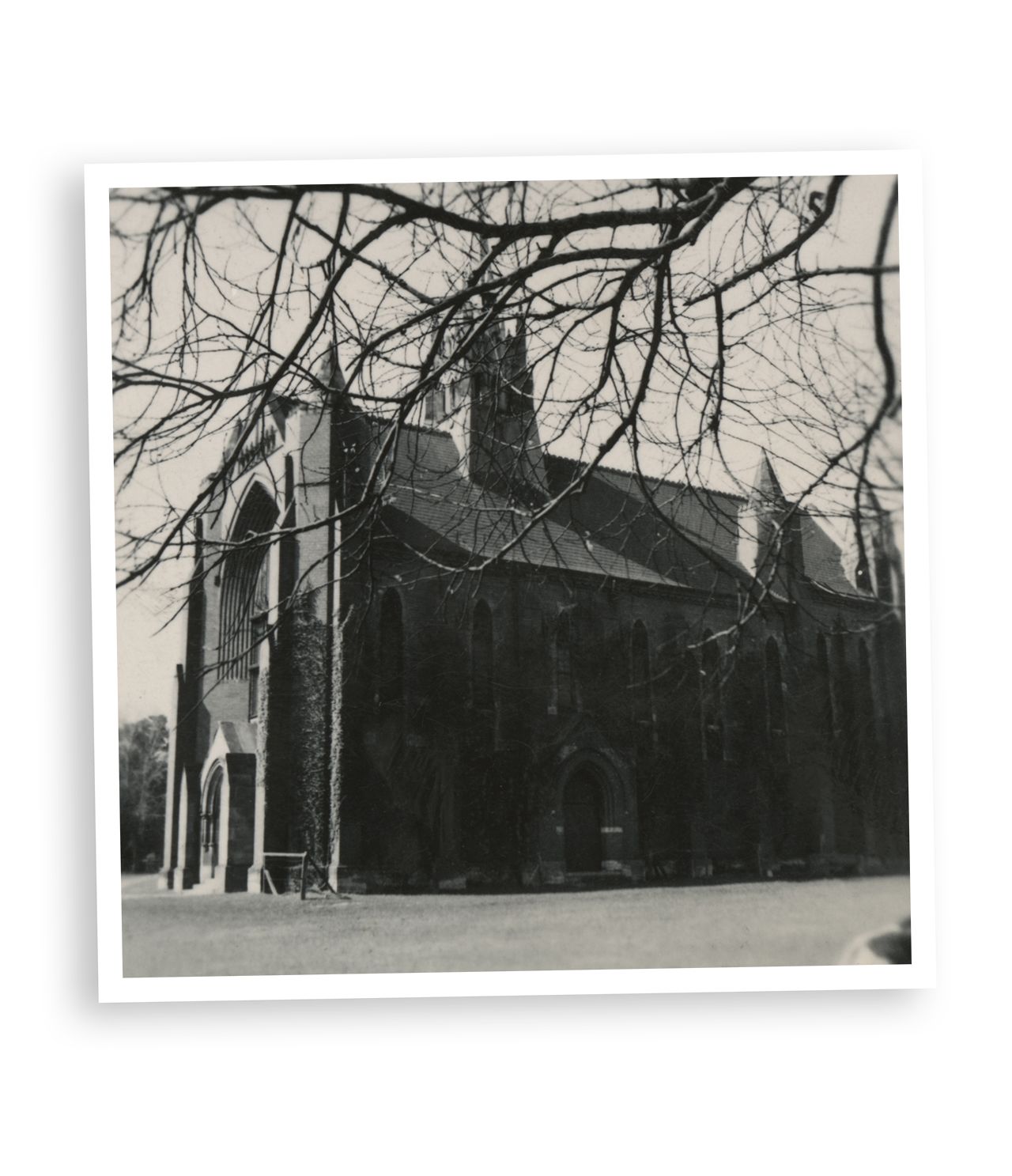
Trinity College Chapel, c. 1930s. Trinity College Archives, MM 000201
Trinity College Chapel, c. 1930s. Trinity College Archives, MM 000201
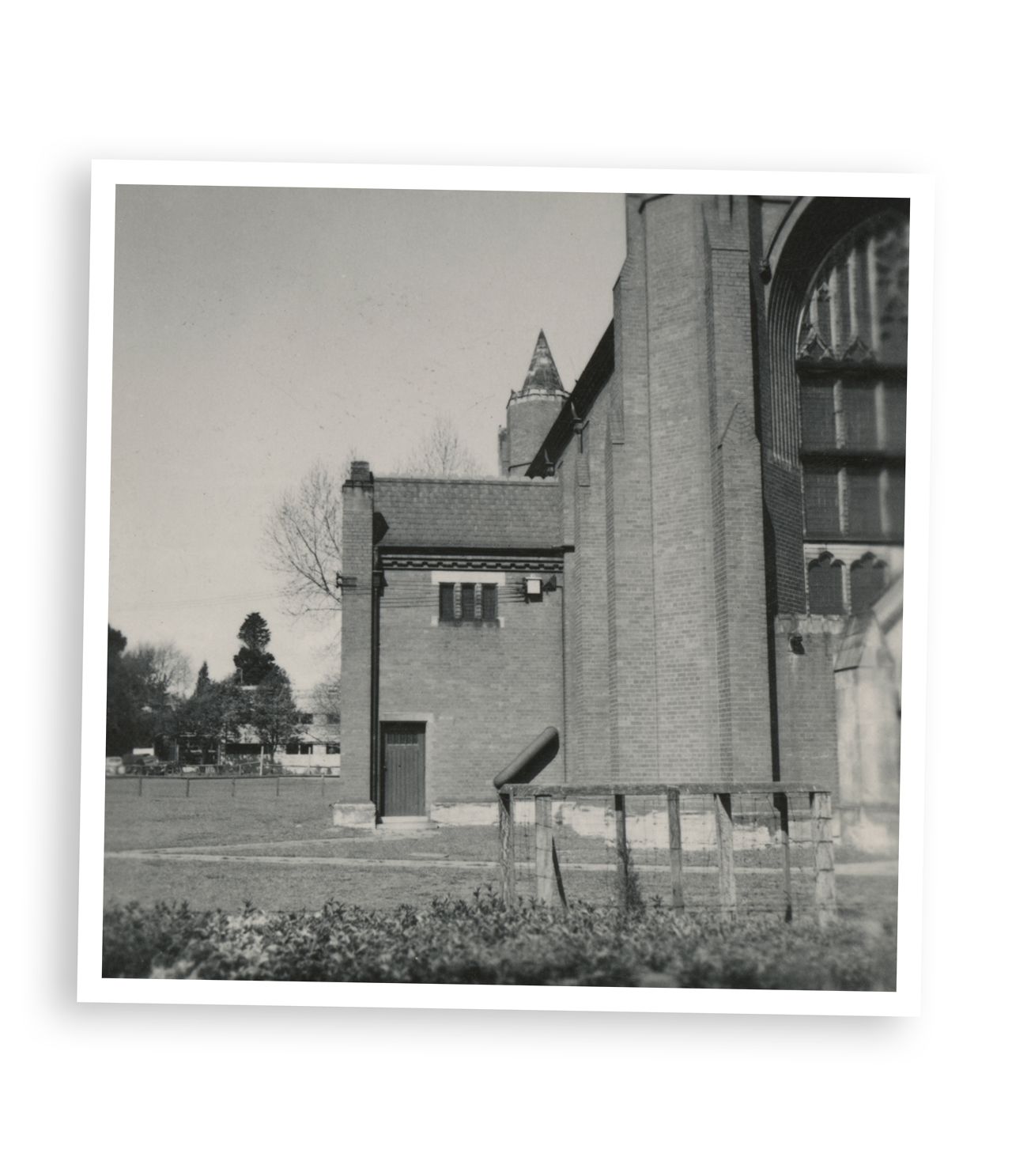
Trinity College Chapel prior to the addition of the northern annexe in the 1950s, c. 1930s. Trinity College Archives, MM 000200
Trinity College Chapel prior to the addition of the northern annexe in the 1950s, c. 1930s. Trinity College Archives, MM 000200
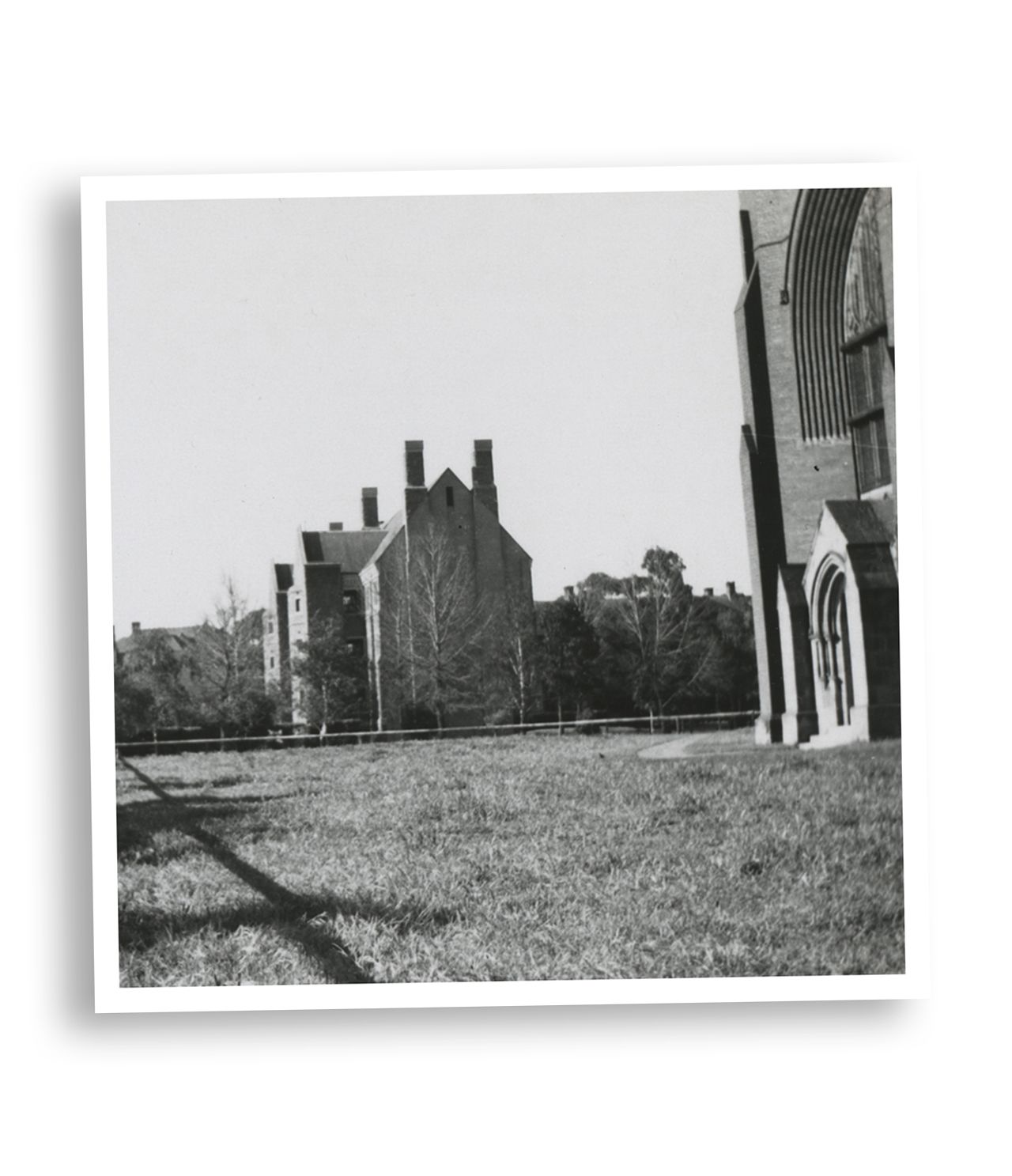
View north from near the Chapel to Behan Building, prior to the construction of Cowan Building, c. 1930s. Trinity College Archives, MM 003058
View north from near the Chapel to Behan Building, prior to the construction of Cowan Building, c. 1930s. Trinity College Archives, MM 003058
Once glorious in its isolation on the Bulpadock
Attendance at Chapel was compulsory during much of the first half of the twentieth century, for both the 'gentlemen' of the College as well as the 'ladies' of the adjoining College Women's Hostel, Janet Clarke Hall.
That had its detractors as much as its supporters.
In 1925, the role of Chaplain was established at Trinity through the appointment of Robert Esmond Sutton, and a low sandstone building was erected at the northern end of the Summerhouse lawn as his residence.
Purportedly built from materials 'acquired' from the Newman College building site a few years earlier, it was quickly given the Catholic moniker 'Vatican'.
It saw out almost a century, until demolished in 2019.
It was arguably the arrival of Sutton's successor, 32-year-old Revd Thomas Marshall Robinson in 1927, that saw a significant change.
From the outset, he set about raising the standard of worship in chapel, through new hymns and introducing Compline - evening prayers - as a late, sung service. Servers in the chapel were trained and a 'Guild of the Sanctuary' established, which included a large number of resident students.
The Vatican soon became known for Robinson's supper parties, inviting students to think and discuss the issues of science, religion and philosophy.
By 1932, the Fleur de Lys would write that the 'Chapel continues to flourish', with Monday Evensong being particularly popular.
'We have to thank the Chaplain for reviving the Rusden Club, a society whose aim is the correlation of science and religion.'
As one student enthused in the Fleur de Lys magazine in 1933, during Robinson's term as chaplain, 'It is cheering to find in what is so often described as a godless age, that least there is some religion in Trinity'.
As witness:
'... the increasing number making the Eucharist the supreme act of their worship, and find their frequent and regular Communion the source of divine grace. We might also indicate the nightly Compline, the Tuesday and Saturday night meditations, the celebrations on red-letter days, as well as Wednesdays. If we cast our minds back we remember the enthusiasm for the Holy Week devotions. But the above have not been the private preserve of theologs. - as the composition of the Servers' Guild also indicates.'
When Robinson finished at Trinity some seven years later, he had brought about a significant change in the students and their attitude to the Chapel.
From Trinity, he took up a chaplaincy role at St John's College, Morpeth, in New South Wales. In a later tribute in that college's 'Jubilee Book' in 1948, they described qualities clearly evident during Robinson's time at Trinity - 'the spirit of free, critical enquiry flourishes in the college, and partisanship finds no encouragement to develop'.
With most of the College's buildings concentrated in the north-east of the campus, the Chapel stood largely in isolation until the mid-century brought the expanding residential wings closer.
For many incoming residential students, the Chapel was a recognisable landmark on the tram up from the city by which to identify Trinity. Not always seen in a favourable light, as David Jackson (TC 1932) recalled: 'I knew nothing about Melbourne, not even where the University was located.'
'From the University calendar I knew that Trinity was in the University reserve and that it was bounded on one side by 'Tin Alley' and from some kind friend that it had an ugly chapel.'
Jackson's friend's unflattering description was not born out by others. P.M. Carew-Smythe, director of art education for the Victorian Department of Education, described in glowing terms a similar tram ride up Royal Parade to take in the latest addition to Trinity's campus while it was still under construction.
'The simplicity and vigor of the design, the silhouette of the graceful spire, and the sense of style ... attracted at once. ... It is altogether a most successful composition, and a great pleasure to see.'
Through until the early 1960s, the Chapel remained somewhat detached from the college to the north, except for a well-beaten track that led along the campus' western side that led from the front door northwards towards Trinity and, beyond, Janet Clarke Hall.
The Bulpadock remained fenced, housing the college's herd of cows that grazed up to the building's walls.
James Grant (TC 1950) recalled that, prior to the commencement of the Cowan building in 1963, the Chapel 'looked distinctly forlorn and unloved. Only later did I learn that its placing derived from one of the several master plans for the College that were never implemented'.
The wedding of Dr Hubert Smith (TC 1931) and Beryl Riggall (JCH 1934), officiated by former alumnus and College Chaplain John McKie (TC 1928), 18 August 1950. It was Beryl's second marriage, her late husband William Riggall having been killed in the war. [no audio]
The wedding of Dr Hubert Smith (TC 1931) and Beryl Riggall (JCH 1934), officiated by former alumnus and College Chaplain John McKie (TC 1928), 18 August 1950. It was Beryl's second marriage, her late husband William Riggall having been killed in the war. [no audio]
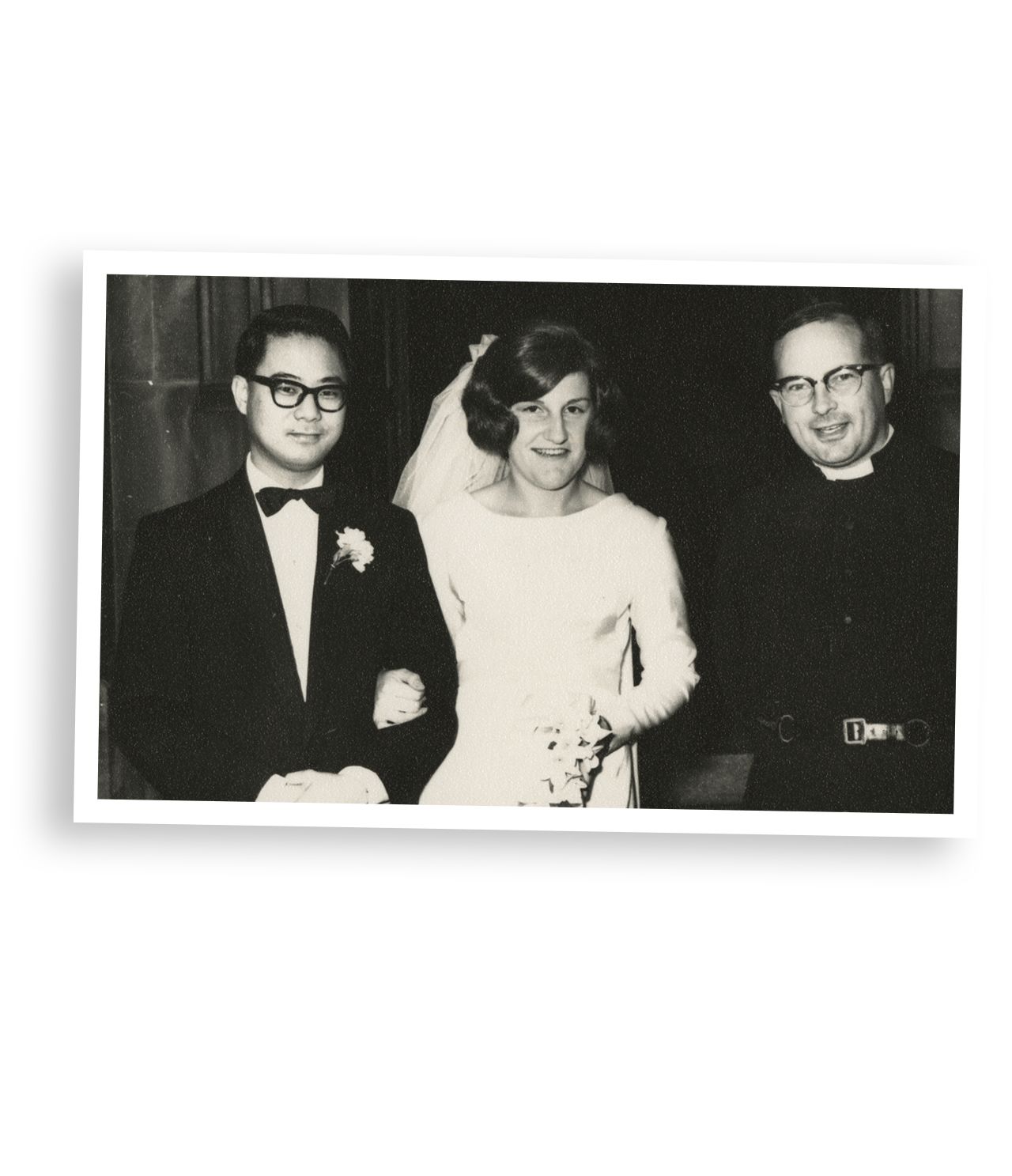
Chaplain Barry Marshall at the wedding of Phillip and Jenny Wong, 1966. Trinity College Archives, MM 000625.
Chaplain Barry Marshall at the wedding of Phillip and Jenny Wong, 1966. Trinity College Archives, MM 000625.
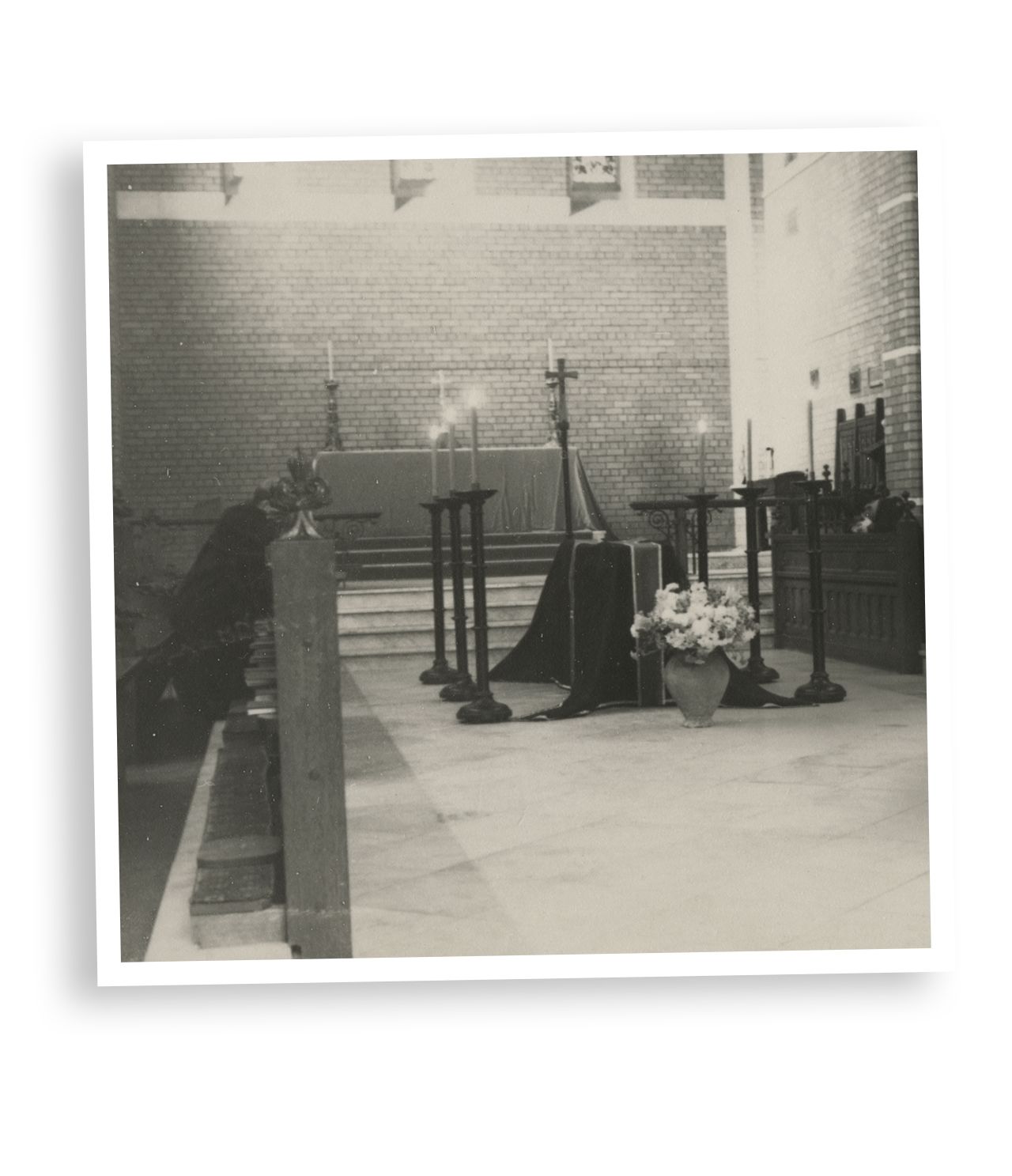
The late Warden Ron Cowan lying in state in the Chapel, 1964. His son Bill (TC 1963) keeps vigil. Trinity College Archives, MM 000285.
The late Warden Ron Cowan lying in state in the Chapel, 1964. His son Bill (TC 1963) keeps vigil. Trinity College Archives, MM 000285.
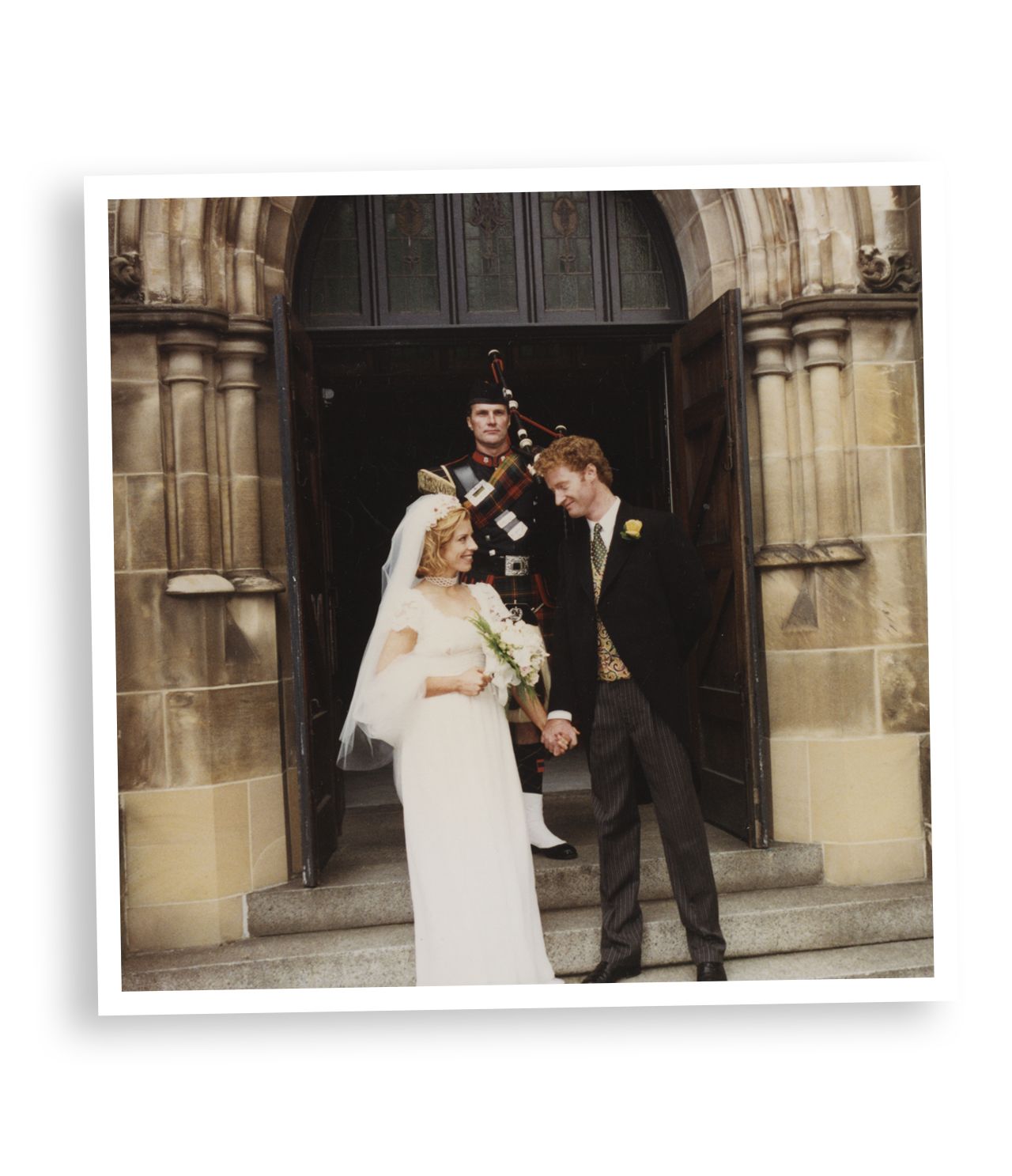
Justin McNab (TC 1985) with bride Julie celebrate their wedding at the Chapel, 1994. Twenty-six years later, their daughter would commence at Trinity. Trinity College Archives, MM 002157
Justin McNab (TC 1985) with bride Julie celebrate their wedding at the Chapel, 1994. Twenty-six years later, their daughter would commence at Trinity. Trinity College Archives, MM 002157
Four weddings and a funeral
Alongside the daily services, the Chapel was soon playing host to a regular stream of weddings, baptisms and the occasional funeral from among the college community. In early years, among a much smaller collegiate community, the student Fleur de Lys magazine would list the various unions - often the result of courting throughout their time at college between recent graduates of Trinity and the neighbouring Janet Clarke Hall.
In 1953, the Fleur de Lys could remark that 'Everyone knows that the Chapel of Trinity College is used':
' ... at almost any waking hour there is someone there, either at a service, or preparing for one, or just doing some music practice. And this is good; for a chapel must be a place apart, yet well known, a familiar sanctuary.'
And a few years later, the students would once again put words to the prevailing sentiment of the role of the Chapel in the collegiate experience: 'The Church did not found this College as a retreat from the "hurly-burly" of the University for pious people. Nor was the Chapel built for individual Christians to find their own "pie in the sky." The College can and should be the Church at work in the University.'
The Chapel should be the centre of our corporate life, where in all humility we meet as one body at the feet of God.
The sudden death of the Warden, Ron Cowan, while in office in 1964 came as a shock to the tight-knit college community. A former intelligence officer during the war, Cowan had been a firm but convivial Warden, actively involved with University football and not unknown for joining the students for a game of billiards in Upper Clarke. Upon his passing, his coffin lay in state in the Chapel.
The student community was changing too, itself a reflection of broader changes across Australian society and its engagement with religion. In 1964, 67% of Trinity students identified as Church of England with a further 7% being 'nominally' the same. But only 19% felt Chapel attendance should be expected of all members of the College. Nonetheless, there was a strong view held in favour of the College being affiliated with the Church, and of theological training being undertaken through Trinity.
The sentiments were even stronger a decade later, when the Fleur de Lys described the situation by suggesting, 'Like one's sex life, one's religious belief is a private affair'. The physical position of the Chapel, 'on the periphery of the collegiate arena', was illustrative of the building's activities and their role in college life. 'It is merely an obstacle to be negotiated on the trip back from Naughton's, the rival temple opposite.'
'As long as the Chapel is seen as an obstacle, no amount of beautiful liturgy, of provocative services, of devoted and regular worship - all of which have characterised the life of the Chapel this year - will allow the Chapel to take its proper place in the life of the College as a whole.'
But another problem beyond the secularisation of Australian society was confronting Alexander North's charming building.
After four decades of use and limited regular maintenance, the condition of the Chapel was causing the vestry no small amount of concern. 'Some renovations have been completed, but there is still much to do', they wrote in the mid-1960s.
'Perhaps the most expensive section is the great west window, which is still being held in position by four wooden beams originally placed there by Mr Wynne in 1933 as a temporary measure. During Melbourne's rainstorms water has poured through gaps in the window, causing considerable damage.'
Despite the pressing urgency of the issue, little would be done - or was able to be done, due to other demands on college finances - for almost a further 20 years.
Conditions grew steadily worse. By 1979, even some in the student body were beginning to lament that the Chapel had been 'virtually forgotten and pushed out of College life.'
Then almost overnight, the situation changed.
A miracle at Trinity
In 1983, the Trinity College Foundation was established, a permanent body 'dedicated to assisting the College to thrive and develop during its second hundred years'.
The College finances, challenged by a raft of pressures that extended back to the mid-century, were now in an acute position. Regular maintenance of the campus had been cut back to the absolute minimum; catering was undertaken via Ormond College through a process known as 'cook-chill', where pre-prepared meals were produced at the neighbouring college and delivered to Trinity once reheated.
Against this backdrop - like John Horsfall 70 years earlier - an unexpected donor appeared.
Robert Cripps had been attending a friend's wedding in the Chapel at the beginning of the 1980s when, while appreciating the beauty of the building, he 'was alarmed to see such a beautiful building deteriorating rapidly'. As the College newsletter reported at the time:
'When he heard that one of the goals of the Foundation was the upgrading of our present buildings and facilities, Mr Cripps commissioned, with the grateful consent of the Council and the Warden, a professional survey by the College Architects and the engineering firm of John Connell - Mott, Hay & Anderson - of exactly what needs to be done and the estimated cost.'
Nor was such philanthropic support out of the ordinary.
The Cripps Foundation had already been generous benefactors to St John's College and Selwyn College in Cambridge, and to the University of Nottingham.
As early as the mid-1960s, the family's Foundation had supported St John's new residential wing, the 'Cripps Building', while Selwyn's 'Cripps Court' opened in 1969. With a passion for supporting a rich, educational environment, Trinity's Chapel would now be saved by the family's largesse.
It was, as the newspaper Church Scene would write, 'A miracle at Trinity.'
Work on the increasingly dangerous west window was the first priority. For almost a year, the western end of the Chapel was cloaked in scaffolding as the glass was removed, stonework repaired, the whole being completed in time for the 'Festival of Lessons and Carols' in 1982, in which the Governor-General Sir Ninian Stephen and his wife Lady Stephen were in attendance.
The west window having been secured, the scaffolding began to wrap around the building towards the east, and upwards to assess Melbourne's 'most beautiful little spire'.
However, once the stonemasons reached it, to their dismay 'they found that its condition was, if anything, even more dangerous than that of the west window.'
The restoration work was capturing Melbourne's attention. Newspapers ran stories, and in June 1982, the National Trust of Victoria formally added the Chapel to their Heritage Register, praising it in glowing terms:
'An early and outstanding example of the work of North and Williams in which the Decorated Gothic style is dramatically interpreted in the manner of the Arts and Crafts. The exterior is striking in the steep proportions, sheer brick surfaces, simple octagonal turrets, the stylized tracery and eight ringed arch of the great west window, and the complex central lantern spire.'
It was almost poetic when, in 1983, the director of Trinity's Theological School John Gaden and wife Janet gifted a large, bronze medallion by noted Australian sculptor Michael Meszaros to the Chapel.
The medallion augmented the 14 'Stations of the Cross' produced by Michael's father, artist Andor Meszaros, and continued the theme of the father's series in depicting 'The Resurrection'.
For a resurrection was indeed exactly what had taken place.
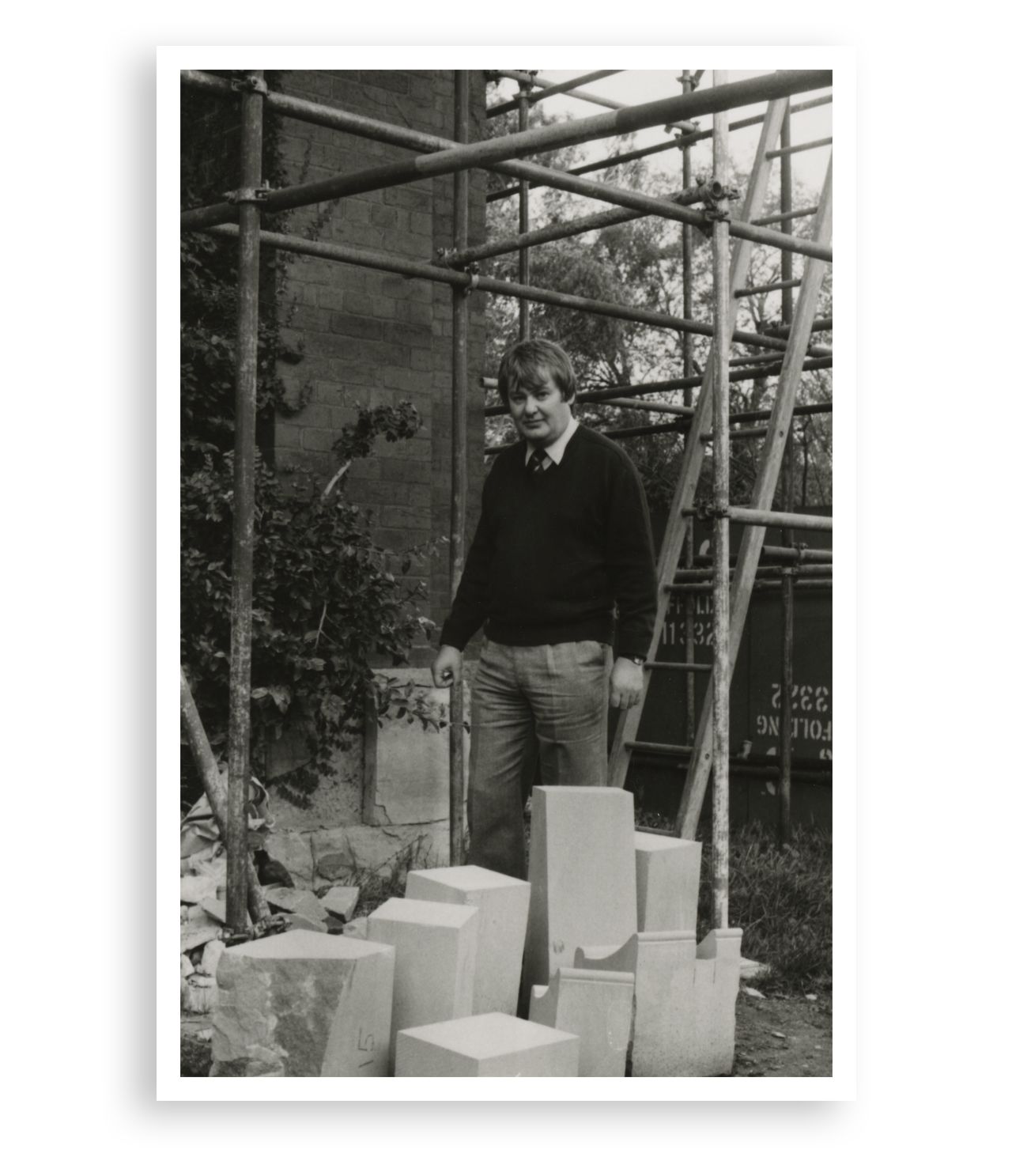
Robert Cripps inspecting new sandstone blocks during the restoration of the Chapel's western window, c. 1982. Trinity College Archives, MM 000106
Robert Cripps inspecting new sandstone blocks during the restoration of the Chapel's western window, c. 1982. Trinity College Archives, MM 000106
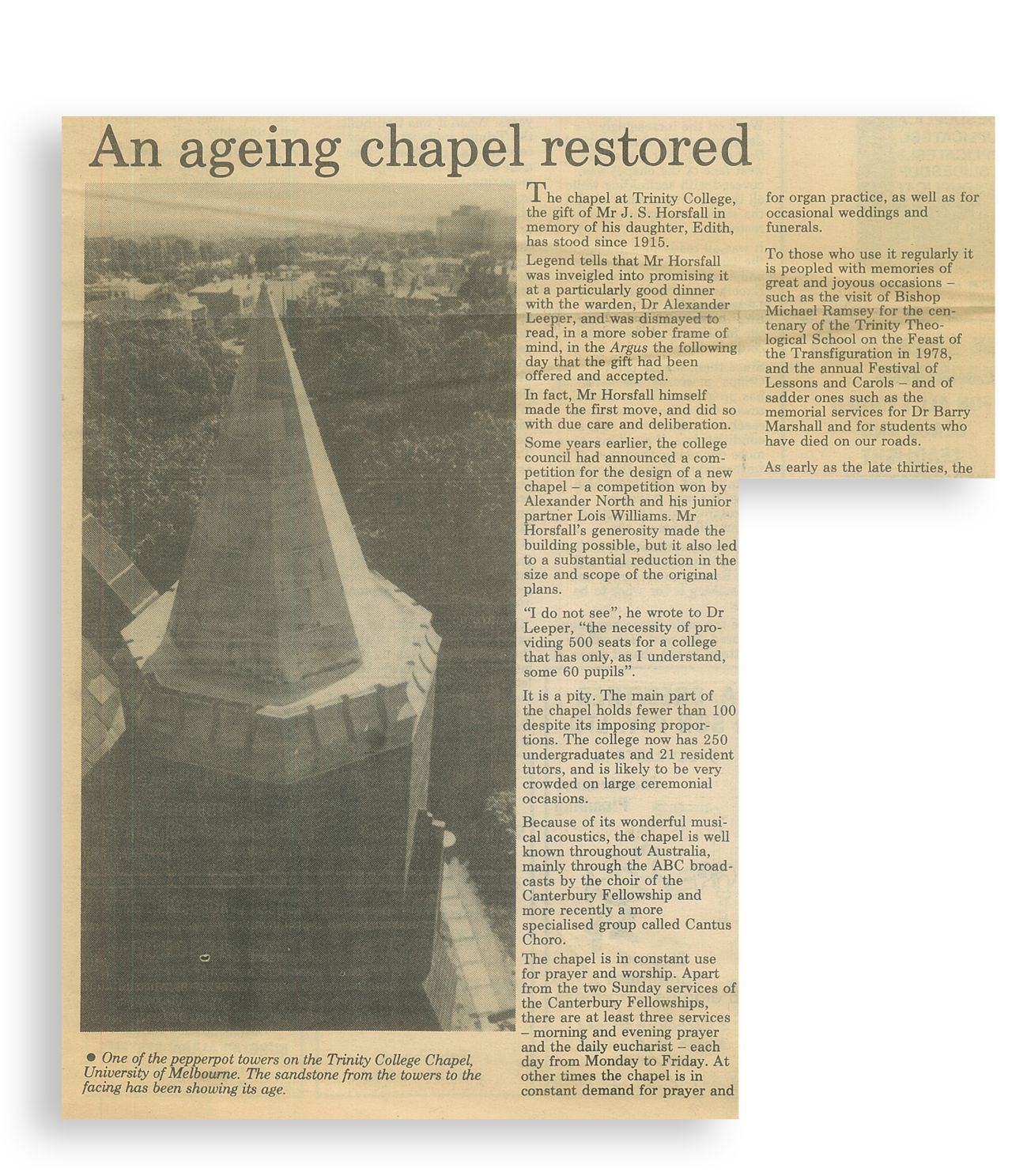
'An ageing chapel restored', Church Scene, 18 November 1983
'An ageing chapel restored', Church Scene, 18 November 1983
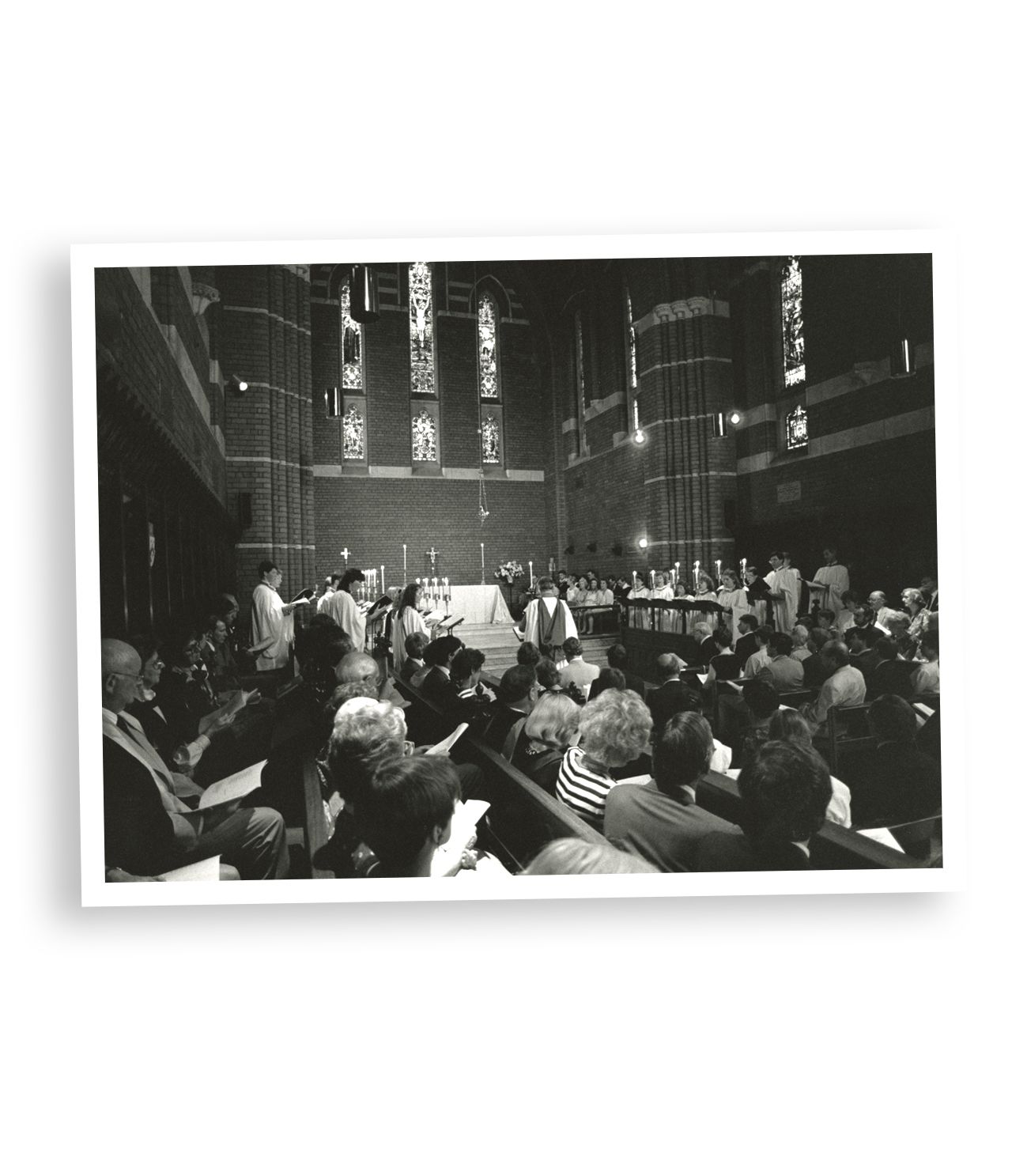
Full house! A packed restored Chapel at the Founders and Benefactors Service in 1987. Trinity College Archives, MM 000758.
Full house! A packed restored Chapel at the Founders and Benefactors Service in 1987. Trinity College Archives, MM 000758.
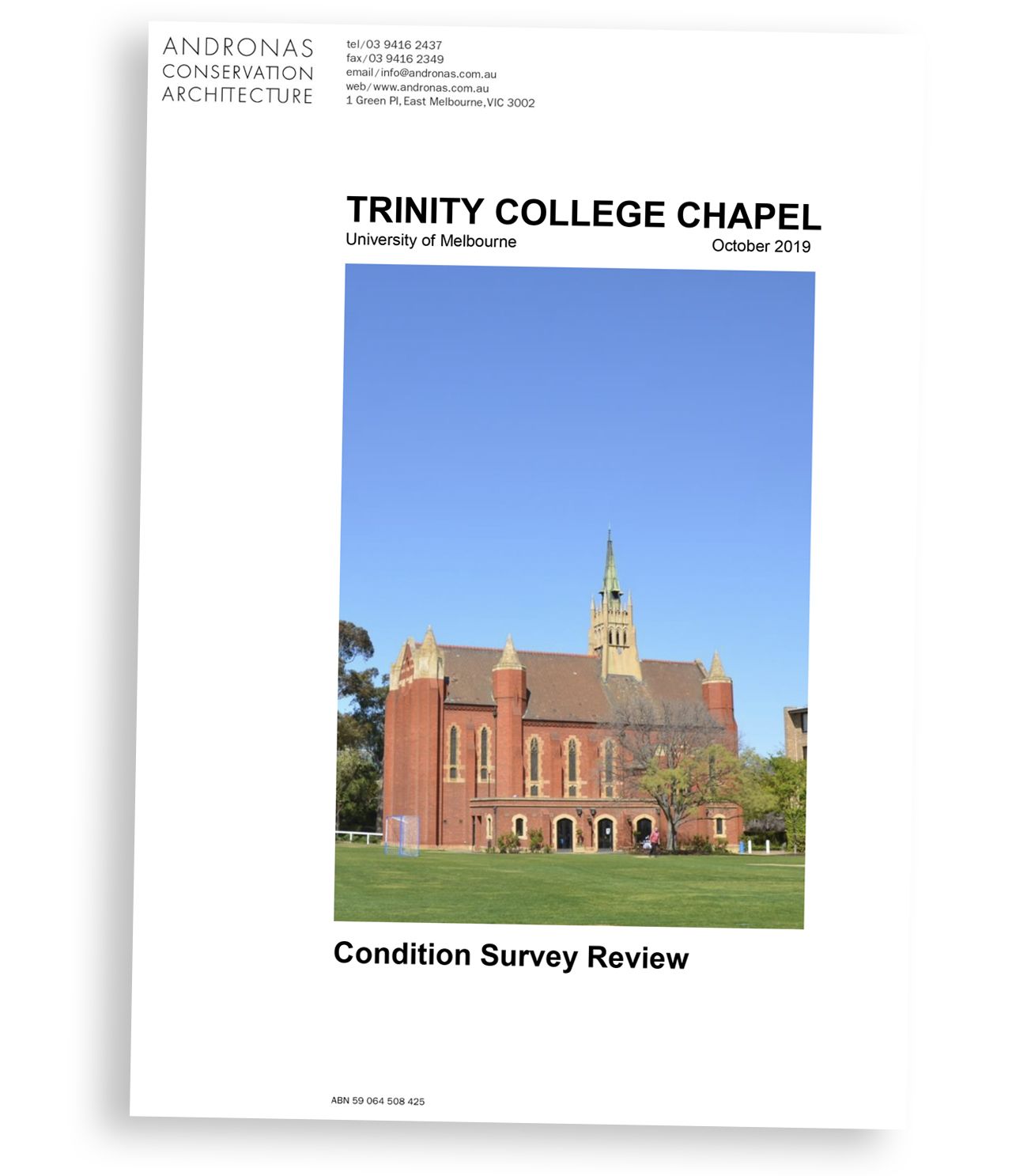
'Trinity College Chapel: Condition Survey', Andronas Conservation Architecture, 2019. Regular condition reporting now forms part of the College's commitment to maintain and preserve the Chapel.
'Trinity College Chapel: Condition Survey', Andronas Conservation Architecture, 2019. Regular condition reporting now forms part of the College's commitment to maintain and preserve the Chapel.
The College grounds as seen from the Chapel spire, with newly restored stonework readily visible in the building's turrets, c. 1983.
Stonemasons removing deteriorating sandstone and refacing the foundation layer.
The entrance to the College Chapel at the beginning of the 1980s, prior to the commencement of much-needed restorative work.
The newly paved forecourt of the College Chapel following restoration work to the building, c. 1983.
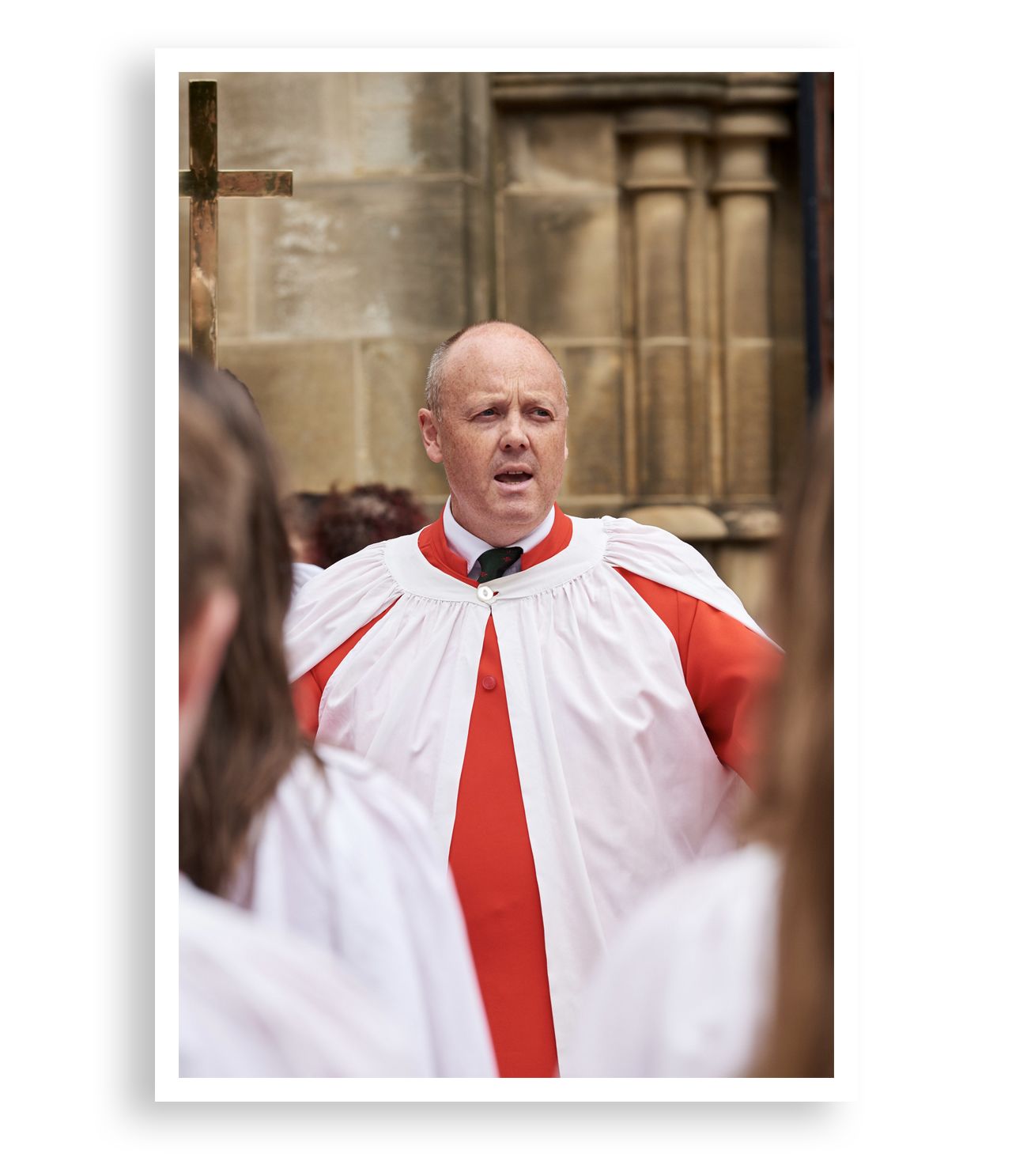
Former Tallis Scholar and Director of Music at Trinity, Chris Watson has continued to raise the standard of the College's choir to an international level.
Former Tallis Scholar and Director of Music at Trinity, Chris Watson has continued to raise the standard of the College's choir to an international level.
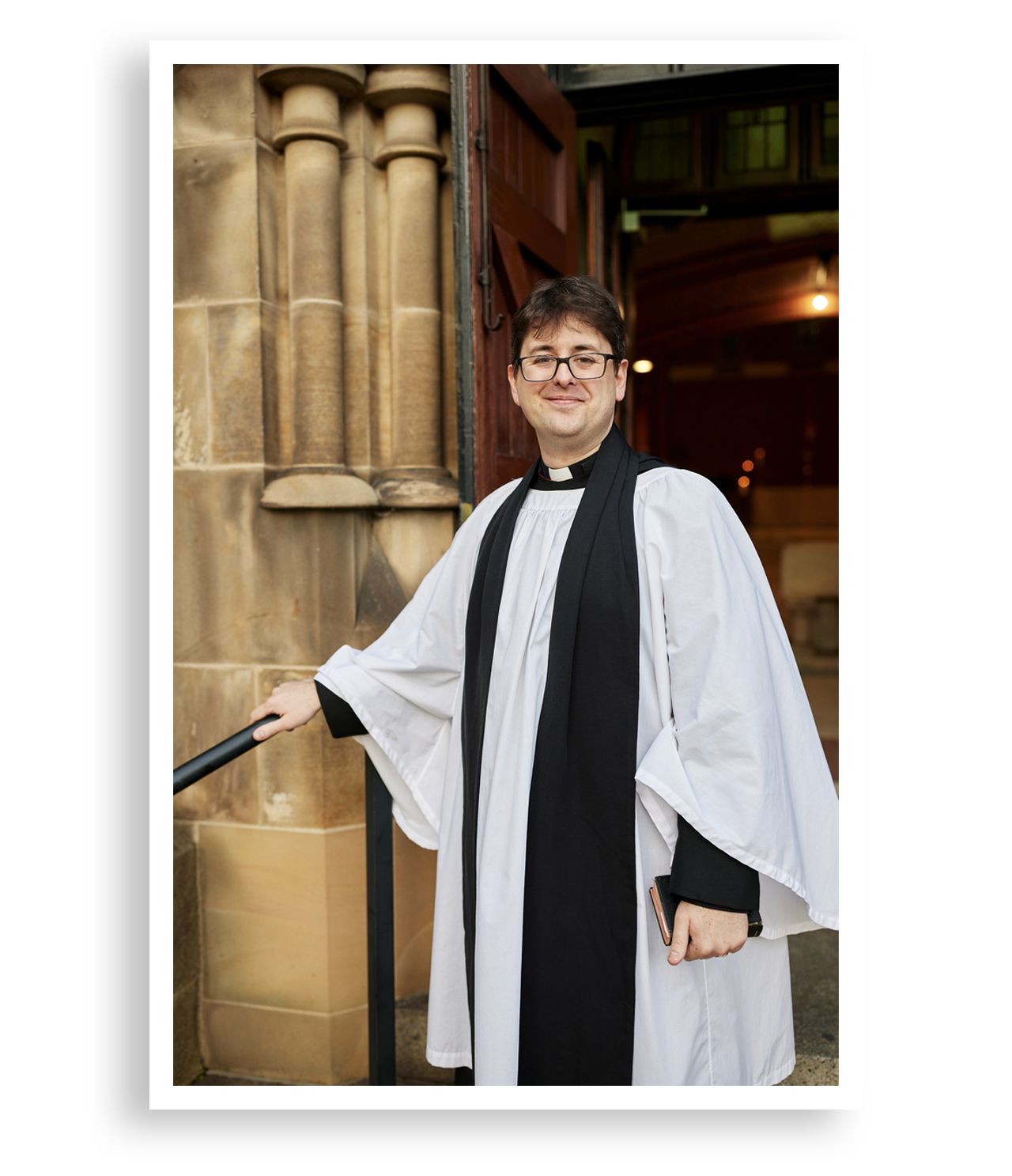
Revd Dr Luke Hopkins (TCTS 2015) returned to Trinity at the beginning of 2022 to commence in the role as College Chaplain.
Revd Dr Luke Hopkins (TCTS 2015) returned to Trinity at the beginning of 2022 to commence in the role as College Chaplain.
A Chapel for the 21st century
Some 40 years after the generosity of the Cripps Foundation allowed for the last major renovation, the Trinity College Chapel continues to play a significant part in college life.
In November 2017, the College marked the centenary of the Chapel's consecration. The then Chaplain the Revd Samuel Dow described Alexander North's design as 'an incredible gift to our community life', a place of worship and prayer, and 'one of the most valuable underpinnings of the life of our college'.
Annual carols services at Christmas continue to be an important calendar event for the entire college community and a fitting way to celebrate and recognise the end of the year. Special services throughout the year compliment formal dinners of the college's community.
Moreover, the daily liturgical routines continue, and indeed have been strengthened over the years. Daily morning prayers are held for staff and students alike, Eucharists are conducted throughout the week, Choral Evensongs are held every Sunday, while visiting academics of Trinity's Theological School partake in the life of the Chapel.
In 2017, Christopher Watson joined the College staff as Director of Music, stewarding Trinity's renowned choir and actively involved in all facets of the musical life of the College.
A former Tallis Scholar from St Edmund Hall, Oxford, Watson brought a strong sense of the Oxbridge choral and liturgical traditions to Trinity.
'It's such a lovely service,' he says of Tenebrae, the Easter service where the lights of the chapel are gradually extinguished until just one candle is left burning. 'The music written for that part of the church year is sublime.'
In February 2022, after the challenging past few years of the COVID-19 pandemic, returning graduate of the Theological School, the Revd Dr Luke Hopkins, commenced as College Chaplain.
He enthuses about his new role and the opportunities that lie ahead, explaining:
'The College chaplain is there for the entire Trinity community – the Residential College, Pathways School and Theological School. I’m there to help with the wellbeing of everyone who makes up the Trinity community.'
The latest census shows an increase in the number of Australians that identify as secular. For a college that was founded and stands upon the traditions of its Anglican heritage, it is reassuring to see that chaplaincy and the vision of Alexander North's beautiful red-brick Chapel are in good hands, ready to face the challenges of the 21st century.

Dr Ben Thomas, Rusden Curator, Cultural Collections
curator@trinity.unimelb.edu.au





